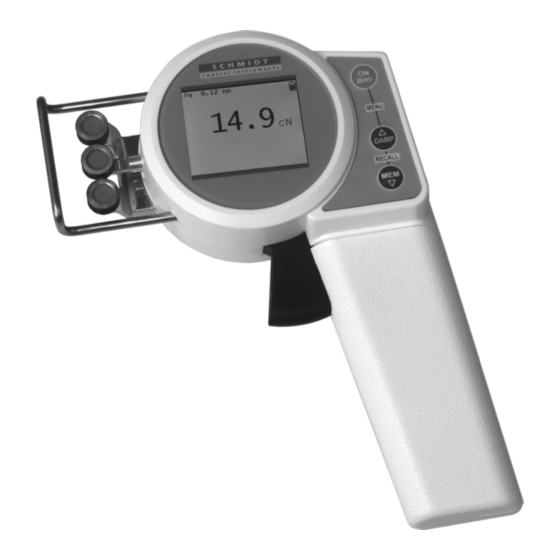
Summarization of Contents
Warranty and Liability
Notices within Operating Instructions
Basic safety notices and instructions for safe operation are essential for handling and operation.
Responsibilities of the Operating Company
Operating company must ensure personnel are trained and familiar with safety regulations.
Responsibilities of the Personnel
Personnel must observe safety regulations and understand operating instructions before starting work.
Informal Safety Measures
Keep operating instructions handy and comply with valid safety and environmental regulations.
Personnel Training
Only trained personnel may operate the device; trainees need supervision.
Intended Use
Device is for tension measurement only; misuse is not covered.
Dangers in Handling the Device
Device can cause injury; use for intended purpose and in faultless condition.
Copyright Notice
Copyright of operating instructions remains with the company.
Declarations and Registrations
Compliance with EU Directives and registration under German law.
Available Models
Technical Specifications
Detailed technical specifications including calibration, units, accuracy, and power supply.
ZEF Guide Rollers Details
Details on V-grooved ZEF guide rollers and their material and speed.
ZED Guide Rollers Details
Details on V-grooved ZED guide rollers and their material and speed.
Connecting the Tension Meter
CE specification compliance requires using HANS SCHMIDT equipment.
Package Contents
List of items included in the tension meter package.
Unpacking Instructions
Instructions for unpacking and inspecting the tension meter for damage.
Operations
Pre-Measurement Safety Notes
Read and understand instructions, wear protective clothing, avoid moving rollers by hand.
Operating and Display Elements Overview
Identifies and describes the various buttons, display, and physical components of the tension meter.
Numeric Display Details
Explains the elements displayed numerically, including current reading, damping, and status indicators.
Bargraph Display Details
Describes the bargraph display showing current reading, MIN/MAX alarm, and tension range.
Graphic Display Details
Explains the graphic display for trend monitoring, including measured values and time axis.
Device Setup
Covers battery charging and initial setup procedures for the tension meter.
Battery Charging
Instructions for charging the LiPo battery, including temperature limits and adapter use.
Switching On the Tension Meter
Procedure for turning on the device, including automatic zero adjustment.
Switching Off the Tension Meter
Methods for manually or automatically switching off the tension meter.
Tension Meter Settings
Describes how to navigate menus and adjust various settings like material, display, and units.
Material Setup and Calibration
Selecting and setting up material characteristics, including calibration and limits.
Display Options
Options for display modes: Numeric, Bargraph, and Graphic.
Time Scale Setting
Setting the time period for the graphic display.
Alarm Function
Activating or deactivating the alarm function.
Damping Value Adjustment
Setting the damping factor for reducing value fluctuations.
Tension Unit Selection
Selecting the measurement unit for tension (cN, g, lb, N).
Backlight Adjustment
Adjusting the display brightness.
Background Color
Choosing between white or black display background.
Screen Rotation
Setting display rotation for fixed or automatic orientation.
Auto Power Off Function
Enabling or disabling the automatic power-off feature.
Language Selection
Selecting the user interface language.
Factory Reset Procedure
Resetting the tension meter to its original factory settings.
Material Setup Menu Details
Details on setting material characteristics, limits, and calibration points.
Factory Reset Details
Procedure and consequences of resetting the device to factory default settings.
Operation Procedure
Steps required before performing measurements, including settings and zero adjustment.
Zero Adjustment Procedure
How to perform manual zero adjustment if the automatic adjustment is not accurate.
Material Insertion and Removal
Detailed steps for loading and unloading the material being measured.
Damping Feature
Explanation of the damping feature and how it affects displayed values.
Using the Alarm Function
Requirements and steps for activating and using the MIN/MAX alarm function.
Creating Material Characteristics
Guide to creating custom material characteristics, with factory calibration noted.
Calibration Setup
Instructions on how to set up the device for calibration using weights.
Calibration Procedure
Steps for performing calibration using weights at specific percentages of the measuring range.
Verifying Calibration
How to check the accuracy of a performed calibration using suspended weights.
Memory Functions
Storing, displaying, and deleting measured values and statistical data.
Service and Maintenance
Spare Roller Information
Information on ordering spare rollers for ZEF and ZED models.
Cleaning
Cleaning Solvents Warning
Warning against using aggressive solvents for cleaning the unit.
Verification Interval
Recommended Verification Interval
Recommendations for determining the frequency of calibration verification, suggesting one year.
Calibration Verification and Repair Cost Determination
Calibration Verification Flow Chart
Visual representation of the process for verifying calibration and determining repair costs.
Correspondence
Correspondence Information
Information to provide when contacting the company for questions or issues.
Repairs
Shipping Instructions for Repairs
Guidelines for shipping the instrument for repair, including documentation and costs.
















Need help?
Do you have a question about the ZEF-100 and is the answer not in the manual?
Questions and answers